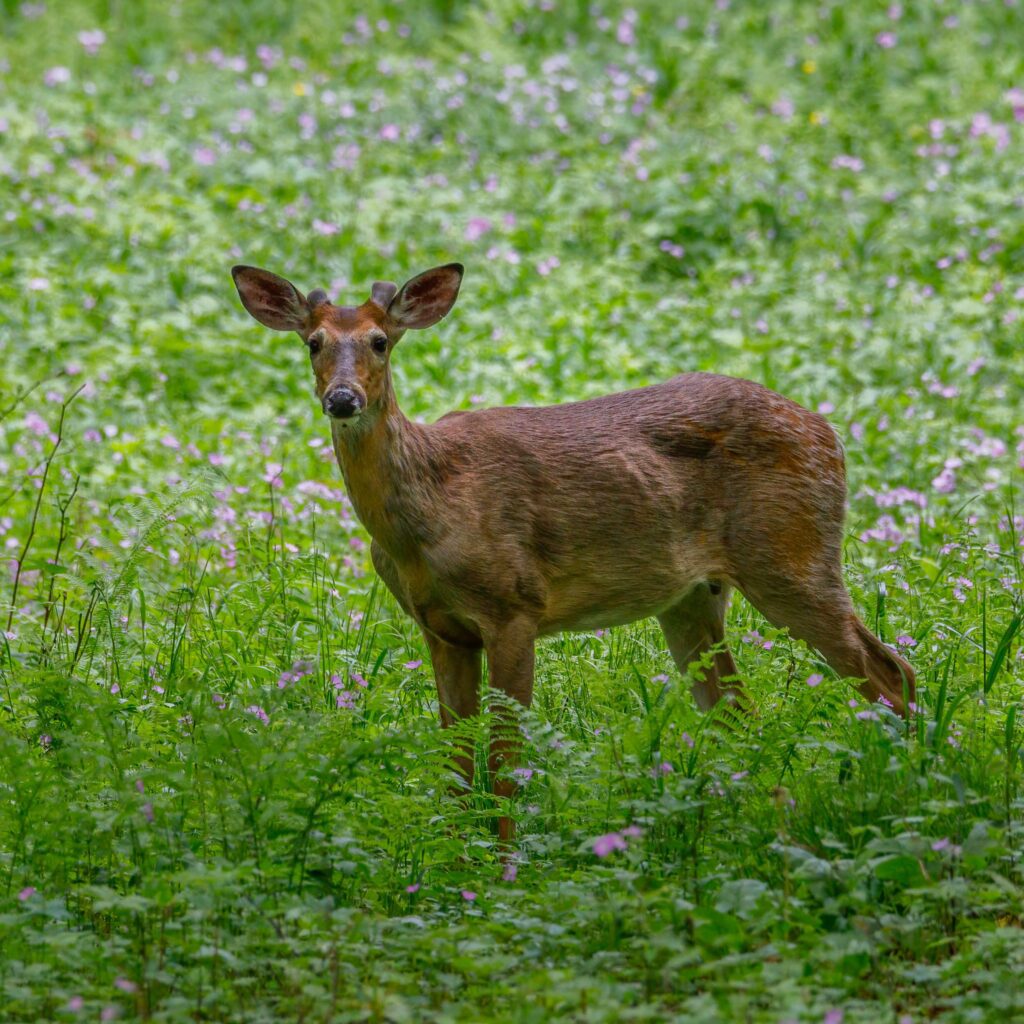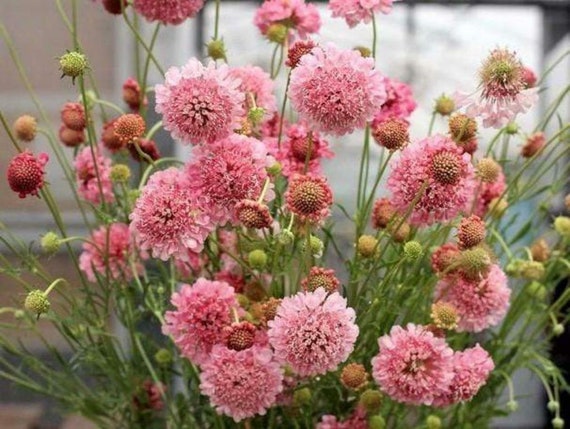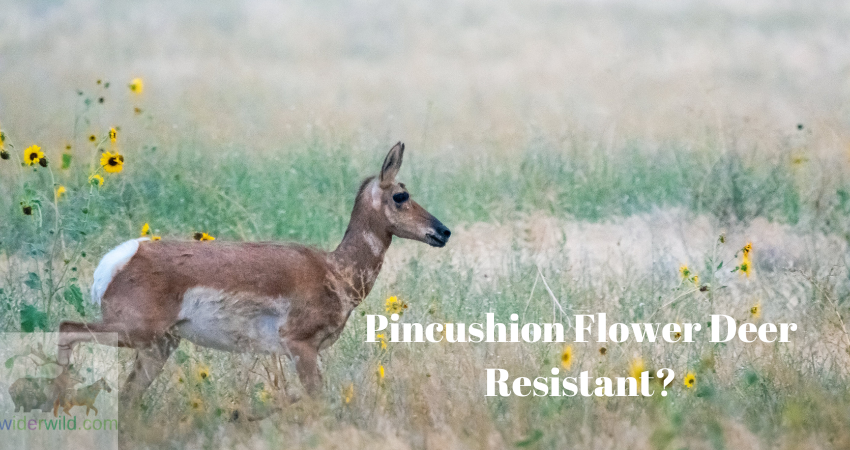Pincushion flower is deer resistant, making it a great choice for gardens prone to deer damage. These beautiful plants are not appealing to deer and will help keep your garden safe from their grazing.
Pincushion flowers are a popular choice for many gardeners due to their vibrant colors, unique flower shape, and ability to attract pollinators. In addition to being deer-resistant, they are also easy to care for and can thrive in various growing conditions.
Whether you have a large garden or a small balcony, pincushion flowers can add beauty and charm to your outdoor space while keeping the deer at bay.
The Deer Resistance Of Pincushion Flowers
Pincushion flowers, with their delicate blooms and vibrant colors, are a popular choice for many garden enthusiasts. Not only do they add beauty to any landscape, but they also offer the advantage of being deer-resistant.
Knowing why deer don’t like pincushion flowers is crucial for gardeners who want to keep their plants safe from these inquisitive animals. Here I will delve into what makes pincushion flowers unattractive to deer and the factors that affect their resistance.
Characteristics Of Pincushion Flowers That Deter Deer

Photo by Aaron J Hill
Pincushion flowers possess certain characteristics that make them less desirable to deer. These characteristics act as natural deterrents, preventing deer from feasting on your precious blooms. Let’s take a closer look at some of these features:
- Spiky Foliage: Pincushion flowers have prickly or spiky foliage, making them unpalatable to deer. The texture and sharpness of their leaves make it uncomfortable for deer to nibble on them.
- Strong Aromatic Scent: Another factor that deters deer from pincushion flowers is their strong aromatic scent. These flowers produce a fragrance that repels deer, as they dislike the intensity of the scent.
- Bitter-tasting Nectar: Pincushion flowers are known to produce nectar with a bitter taste. This bitterness discourages deer from consuming the flower’s nectar, making them less likely to visit and damage the blooms.
Factors Influencing Deer Resistance Of Pincushion Flowers

While pincushion flowers possess natural deterrents, it is important to consider additional factors that can influence their deer resistance. These factors can impact the success of using pincushion flowers as a method of deer control in your garden. Some of these factors include the following:
Local Deer Population: The size and behavior of the deer population in your area can greatly influence the deer’s resistance to pincushion flowers.
In areas with a larger deer population, deer may be more determined to find alternative food sources, making your pincushion flowers more susceptible to browsing.
Availability of Other Food Sources: The availability of natural forage and alternative food sources can also impact the deer resistance of pincushion flowers.
When alternative food sources such as shrubs, trees, or grasses are scarce, deer may be more likely to target your pincushion flowers as a food source.
Drought and Hungry Deer: During times of drought or when deer are experiencing hunger, their inclination to feed on pincushion flowers may increase.
These circumstances can weaken any natural resistance mechanisms the flowers possess, as hungry deer become less selective in their feeding habits.
Understanding the deer resistance of pincushion flowers can help you make informed decisions when selecting plants for your garden.
By considering the characteristics that deter deer and the factors that influence their resistance, you can create a beautiful landscape that remains untouched by these voracious herbivores.
Read More: Is Lobelia Deer resistant
Best Varieties Of Pincushion Flowers For Deer Resistance
Pincushion flowers are a beautiful addition to any garden, but if you’re dealing with pesky deer, finding deer-resistant varieties is essential. These flowers not only add vibrant colors and unique textures to your garden, but they also have properties that deter deer from feasting on your plants. In this section, i will explore some of the best varieties of pincushion flowers known for their deer resistance.
Top Deer-resistant Pincushion Flower Varieties
When selecting pincushion flowers for your garden, it’s important to choose varieties that are known for their deer resistance.
Here are some top choices:
Scabiosa caucasica: This variety of pincushion flowers is known for its ability to resist deer. With its tall stems and delicate lavender-blue flowers, it adds an elegant touch to any garden.
Scabiosa columbaria: Another deer-resistant variety, Scabiosa columbaria, features beautiful ice-blue flowers that resemble pincushions. It’s a low-maintenance plant that can withstand deer browsing.
Knautia Macedonica: This variety stands out with its deep red flowers that attract butterflies and bees but repel deer. Its long blooming period and heat tolerance make it an excellent choice for a deer-resistant garden.
Centaurea Montana: Also known as mountain bluet, Centaurea Montana showcases vibrant purple-blue flowers that deer tend to avoid. Its low-growing habit and resistance to deer make it a great addition to borders or rock gardens.
Echinops Ritro: With its spiky globe-shaped flowers, Echinops Ritro provides a unique architectural element to your garden. It is highly deer-resistant and offers a mesmerizing display of deep blue blooms.
Examining The Traits And Features Of Deer-resistant Varieties
So what makes these pincushion flower varieties deer-resistant?
Let’s take a closer look at their traits and features:
1. Scent:
Deer dislike strong aromas, and many of these pincushion flower varieties have a scent that deters them. The distinct fragrance these flowers emit creates a natural barrier that keeps deer at bay.
2. Texture:
The texture of the leaves and stems of these plants is less appealing to deer. Their fuzzy or prickly surface makes it difficult for deer to graze on them, discouraging them from feeding on your precious flowers.
3. Drought Tolerance:
Deer-resistant varieties of pincushion flowers are often drought-tolerant, meaning they can survive in dry conditions. This is advantageous as deer are more likely to seek out well-watered plants before turning to those that can withstand drought.
4. Natural Defense Mechanisms:
Some of these pincushion flower varieties produce chemicals that are unappealing to deer. These natural defense mechanisms make the plants less palatable, thus reducing the chances of deer feeding on them.
By incorporating these deer-resistant pincushion flower varieties into your garden, you can enjoy their beauty without worrying about deer damage.
Their scent, texture, drought tolerance, and natural defense mechanisms all play a role in repelling deer, ensuring your garden remains a sanctuary of vibrant blooms.
Cultivating Deer-resistant Pincushion Flowers
Pincushion flowers are a charming addition to any garden, with their vibrant colors and unique compact shape. These delightful flowers are not only attractive to the human eye but also have the added benefit of being deer-resistant.
If you’ve been struggling to keep pesky deer away from your garden, pincushion flowers might just be the solution you’ve been searching for.
Here i will explore some tips and strategies for cultivating a deer-resistant garden with pincushion flowers.
Tips For Creating A Deer-resistant Garden With Pincushion Flowers
When creating a deer-resistant garden, it’s essential to keep in mind that no plant is completely immune to deer. There are certain steps you can take to discourage these curious creatures from munching on your precious pincushion flowers.
Here are a few tips:
Choose deer-resistant varieties: Not all pincushion flowers are created equal when it comes to keeping deer at bay. Look for varieties that are known to be less appealing to deer, such as Scabiosa caucasica or Scabiosa columbaria. These varieties have a bitter taste that deer tend to avoid.
Fence your garden: One of the most effective ways to deter deer from entering your garden is to install a sturdy fence. Make sure the fence is at least 8 feet tall and extends a few inches below the ground to prevent deer from digging underneath.
Use deer repellents: Consider using natural deer repellents, such as diluted garlic or chili pepper sprays, around your pincushion flowers. The strong odor and taste can help keep deer at a distance. Just be sure to reapply after rainfall.
Plant in groups: Pincushion flowers tend to fare better when planted in groups rather than as individual specimens. This not only creates a more visually striking display but also makes it harder for deer to navigate through the garden, deterring them from approaching your pincushion flowers.
Companion Planting Strategies For Deer Deterrence
In addition to the above tips, implementing companion planting strategies can further enhance your deer-resistant garden. Certain plants act as natural deterrents to deer, helping to protect your pincushion flowers. Here are a few companion planting options:
| Companion Plant | Beneficial Qualities |
|---|---|
| Lavender (Lavandula) | Repels deer with its strong fragrance while attracting beneficial pollinators. |
| Rosemary (Rosmarinus officinalis) | The strong aroma of rosemary acts as a natural deer repellent. |
| Marigold (Tagetes) | The bright colors of marigolds can confuse and deter deer from approaching your garden. |
By incorporating these companion plants alongside your pincushion flowers, you can create a harmonious and deer-resistant garden that not only looks beautiful but also keeps unwanted visitors at bay.
Managing Deer In The Garden
Dealing with deer in the garden can be a real headache for many gardeners. These graceful creatures may be a delight to observe from a distance, but when it comes to protecting your prized plants, they can quickly become a nuisance.
There are several effective techniques you can implement to deter deer from wreaking havoc in your foliage oasis.
Implementing Deer Deterrent Techniques In The Garden
When deterring deer, prevention is key. By implementing various deer deterrent techniques, you can significantly reduce the chances of these hungry herbivores devouring your garden. Here are a few effective techniques:
Fencing: Erecting a sturdy fence around your garden is one of the most reliable ways to keep deer out. A fence with a minimum height of 7 to 8 feet should be enough to discourage most deer from attempting to enter your garden.
Repellent Plants: Introducing plants that deer find unappetizing can serve as a natural deterrent. Pincushion flowers, also known as scabiosa, are a popular choice due to their distinctive appearance and deer-resistant nature.
Noise and Motion Sensors: Deer are skittish creatures, and unexpected sounds or sudden movements can startle them. Consider installing noise or motion sensor devices in your garden. These devices emit loud noises or trigger sudden movements, scaring away any potential intruders.
Ultrasonic Devices: Ultrasonic devices emit high-frequency sounds that are inaudible to humans but irritating to deer. Placing these devices strategically in your garden can help deter deer from approaching your plants.
Read More: Is Gaillardia Deer Resistant
Natural Deer Repellents And Effective Techniques
There are various natural repellents you can use to discourage deer from entering your garden.
Here’s a list of some effective deer repellents:
- Hot Pepper Spray: Create a homemade deer repellent by mixing hot pepper sauce or flakes with water. The spicy scent will deter deer from grazing on your plants.
- Garlic and Eggs: Deer dislikes the strong smell of garlic and eggs. Combining these ingredients with water and spraying the mixture on your foliage can create a natural barrier against deer.
- Motion-Activated Water Sprinklers: These ingenious devices use sensors to detect deer movement and then spray a burst of water, startling and deterring them from entering your garden.
- Scented Soap Bars: Hanging scented soap bars around your garden can confuse deer with unfamiliar smells, ultimately deterring them from venturing near your plants.
Managing deer in the garden requires preventive techniques and natural repellents. By implementing these strategies, you can enjoy a flourishing garden without worrying about deer munching on your plants.
Remember to choose deer-resistant plants like pincushion flowers and experiment with different deterrent methods until you find what works best for your garden.
With a little effort and persistence, you can successfully coexist with these graceful creatures while protecting your prized plantings.

Credit: etsy
Frequently Asked Questions For Pincushion Flower Deer Resistant?
Is Pink Mist Pincushion Flower Deer Resistant?
Yes, pink mist pincushion flowers are deer-resistant. They are not usually damaged by deer due to their strong fragrance and bitter taste.
Are Scabiosa Deer And Rabbit Resistant?
Yes, scabiosa is deer and rabbit-resistant. They are not preferred by deer and rabbits due to their natural repellent properties, making them a good choice for gardens.
Is Butterfly Blue Pincushion Deer Resistant?
Butterfly Blue pincushion is not deer resistant; deer may eat it. ‘Butterfly Blue,’ is generally considered deer resistant. Deer tend to avoid plants with strong scents, fuzzy or prickly foliage, or plants that have a bitter taste.
Deer preferences can vary depending on factors such as food availability and the specific deer population in your area. While Butterfly Blue Pincushion may be less preferred by deer, it is still possible for them to browse on these plants if other food sources are limited.
If you have a significant deer problem in your area, it may be wise to consider additional deterrents or protective measures to ensure the health and longevity of your plants.
Is Pincushion Flower Invasive?
No, the pincushion flower is not invasive. It is a non-invasive perennial plant that adds color to gardens without taking over.
Is The Pincushion Flower Deer Resistant?
Yes, pincushion flowers are considered deer-resistant due to their bitter taste and strong scent that repels deer.
What Are The Other Benefits Of Growing Pincushion Flowers?
Apart from being deer-resistant, pincushion flowers attract pollinators, add vibrant colors to your garden, and are low-maintenance plants.
How Tall Do Pincushion Flowers Usually Grow?
Pincushion flowers typically grow to a height of 12 to 24 inches, making them perfect for border planting or container gardening.
Final Words
To sum up, pincushion flowers are an excellent choice for those seeking a deer-resistant plant. Their prickly foliage and vibrant blooms make them unappealing to deer, minimizing the chances of your garden becoming their buffet.
Not only are they attractive, but they also attract pollinators, adding beauty and life to your outdoor space.
So, if you love gardening but want to keep deer at bay, consider planting pincushion flowers for a beautiful and worry-free garden.

